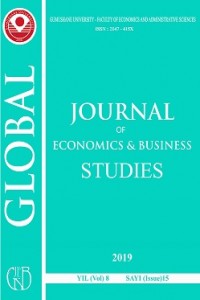Öz
İnsan kaynakları
muhasebesi son yıllarda yaşanan gelişmelere bağlı olarak ortaya çıkan
muhasebeye özgü ve özellikli çalışma alanlarından biridir. Yeni gelişmekte olan
bu ihtisas alanında karşılaşılan en önemli problemlerden biri günümüz
işletmelerinin en değerli varlığı kabul edilen insan kaynağının değerinin
belirlenmesidir. Bu bağlamda işletmelerin sahip olduğu insan kaynağının
değerinin belirlenmesine yönelik bir takım modeller geliştirilmiş olup
sözkonusu modellerin literatürde yeterince incelenmediği görülmektedir. Bu
noktadan hareketle bu çalışmanın amacı, insan kaynakları muhasebesine ilişkin
değerleme modellerini incelemek ve açıklamaktır. Sözkonusu amacı
gerçekleştirmek için insan kaynakları muhasebesine özgü değerleme modelleri
betimsel bir yaklaşımla incelenmiştir.
Anahtar Kelimeler
Kaynakça
- A.A.A. (1973). Report of thecommittee on humanresources.The Accounting Review, 49, Committeereports: Supplementto Volume XLIX of theAccounting Review, 115-124.
- Ahmed, A. (2010). Human resourceaccounting (HRA): Techniquesandaccountingtreatment.InclusiveBangladesh Development Foundation; TheInstitute of CharteredAccountants of Bangladesh (ICAB), 1-14.
- Akinsoyinu, A. B. (1992). Human resourcesaccounting: Themythandreality. TheNigeriaAccountant, 18-20.
- Arkan, T. (2016). Human resourcesaccounting: A suggested model formeasurementandvaluation. Finanse, RynkiFinansowe, UbezpieczeniaCzasopismo, 1(79), 173-193.
- Brummet, R.L.,Flamholtz, E. G. &Pyle, W. C. (1968). Human resourcemeasurement: a challengeforaccountants. Accounting Review,XLIII, 217-224.
- Cherian, J.,&Farouq, S. (2013). A review of humanresourceaccountingandorganizationalperformance. International Journal of Economicsand Finance,5(8),74-83.
- Ciprian, G.G. (2007). Socialaccountingto maket thesocialresultsvisible.
- Dawson C. (1994). Theuse of a simulationmethodologytoexplorehumanresourceaccounting. Management Decision, 32(7). 46-52.
- Ezeagba, C. E. (2014). Theneedforinclusion of humanresourcesaccounting in thebalancesheet. An International MultidisciplinaryJournal,8(2),377-392.
- Flamholtz, E.G. (1974). Human resourceaccounting. California: Dickenson Publishing.
- https://businessdocbox.com(2018)./Human_Resources/71408305-Chapter-3-an-overview-of-models-of-hra.html on 01.04.2018
- Ibarra, V. C.,&Cosico, C. A. (2016). Awareness ofhumanresourceaccountingpracticesandcosting: evidencefromthePhilippines. Global Journal of Business Research, 10(4),27-42.
- Ijeoma, N.,Bilesanmi, A. O., &Aronu, C. O. (2013).Determiningthecontribution of humanresourceaccounting (HRA) on financialstatement of nigerianbanksusingthemantel test analysis. International of Scientific&Technology, 2(10),51-55.
- Kashive, (2002).Importance of humanresourceaccountingpracticesandimplications of measuringvalue of humancapital: casestudy of successfulPSUs in India. XIMB Journal of Case Research 4(2).113-144.
- Kaya, U. (2013). İnsan kaynakları muhasebesi (1.Baskı). İstanbul: Beta Yayınları.
- Nisamudheen, T.,&Mufliha, S. (2016). Human resourceaccountingandauditing. United States: LuluPublication.
- Oluwatoyin, A. S. (2014). Human resourcesaccountinganddisclosure in financialstatement: literaturereview. ResearchJournal of Finance and Accounting, 5(22),64-75.
- Rajsheka, V. (2018). http://shareyouressays.com/knowledge/top-4-methods-used-to-measure-human-resource-in-your-organisation-explained/94579, 21.11.2018.
- Saremi, H.,&Nagshbandi, N. (2012). Impact of humanresourcesaccounting on employees’ performance in organization. International SciencePress, 5(2),199-229.
- Shodganga. Retrieved from http:// shodhganga. inflibnet.ac.in/bitstream/ 10603 /148281/8/08 _chapter%202.pdfon 05.05.2018
- Siegel, J.I.,& G., Shim, J. K. (2005). Dictionary of accountingterms(4th ed.).America: Barron’sEducational Series, Inc.
- Singh, A. (2010). Human resourceaccounting at infosys – a casestudy. 262-273.
- Srivastava, N. (2014). Human resourceaccounting: a strategicaproachtocorparateexcellence. International JournalforResearch in AppliedScienceandEngineeringTechnology, 2(4). 423-428.
- Yadav, S.,College, R., &Prakash, A. (b.t.) Human resourcemanagement. Institute of Lifelonglearning, University of Delhi.
Öz
Human resource accounting is one of the
accounting-specific and featured areas of study that arise due to the
developments in recent years. One of the most important problems encountered in
this new developing field is to determine the value of human resources which is
accepted as the most valuable asset of today's enterprises. In this context, a
number of models have been developed to determine the value of the human
resources of the enterprises and it is seen that these models are not examined
enough in the literature. From this point of view, the aim of this study is to
examine and explain valuation models of human resources accounting. In order to
realize this objective, valuation models specific to human resources accounting
are analysed with a descriptive approach.
Anahtar Kelimeler
Kaynakça
- A.A.A. (1973). Report of thecommittee on humanresources.The Accounting Review, 49, Committeereports: Supplementto Volume XLIX of theAccounting Review, 115-124.
- Ahmed, A. (2010). Human resourceaccounting (HRA): Techniquesandaccountingtreatment.InclusiveBangladesh Development Foundation; TheInstitute of CharteredAccountants of Bangladesh (ICAB), 1-14.
- Akinsoyinu, A. B. (1992). Human resourcesaccounting: Themythandreality. TheNigeriaAccountant, 18-20.
- Arkan, T. (2016). Human resourcesaccounting: A suggested model formeasurementandvaluation. Finanse, RynkiFinansowe, UbezpieczeniaCzasopismo, 1(79), 173-193.
- Brummet, R.L.,Flamholtz, E. G. &Pyle, W. C. (1968). Human resourcemeasurement: a challengeforaccountants. Accounting Review,XLIII, 217-224.
- Cherian, J.,&Farouq, S. (2013). A review of humanresourceaccountingandorganizationalperformance. International Journal of Economicsand Finance,5(8),74-83.
- Ciprian, G.G. (2007). Socialaccountingto maket thesocialresultsvisible.
- Dawson C. (1994). Theuse of a simulationmethodologytoexplorehumanresourceaccounting. Management Decision, 32(7). 46-52.
- Ezeagba, C. E. (2014). Theneedforinclusion of humanresourcesaccounting in thebalancesheet. An International MultidisciplinaryJournal,8(2),377-392.
- Flamholtz, E.G. (1974). Human resourceaccounting. California: Dickenson Publishing.
- https://businessdocbox.com(2018)./Human_Resources/71408305-Chapter-3-an-overview-of-models-of-hra.html on 01.04.2018
- Ibarra, V. C.,&Cosico, C. A. (2016). Awareness ofhumanresourceaccountingpracticesandcosting: evidencefromthePhilippines. Global Journal of Business Research, 10(4),27-42.
- Ijeoma, N.,Bilesanmi, A. O., &Aronu, C. O. (2013).Determiningthecontribution of humanresourceaccounting (HRA) on financialstatement of nigerianbanksusingthemantel test analysis. International of Scientific&Technology, 2(10),51-55.
- Kashive, (2002).Importance of humanresourceaccountingpracticesandimplications of measuringvalue of humancapital: casestudy of successfulPSUs in India. XIMB Journal of Case Research 4(2).113-144.
- Kaya, U. (2013). İnsan kaynakları muhasebesi (1.Baskı). İstanbul: Beta Yayınları.
- Nisamudheen, T.,&Mufliha, S. (2016). Human resourceaccountingandauditing. United States: LuluPublication.
- Oluwatoyin, A. S. (2014). Human resourcesaccountinganddisclosure in financialstatement: literaturereview. ResearchJournal of Finance and Accounting, 5(22),64-75.
- Rajsheka, V. (2018). http://shareyouressays.com/knowledge/top-4-methods-used-to-measure-human-resource-in-your-organisation-explained/94579, 21.11.2018.
- Saremi, H.,&Nagshbandi, N. (2012). Impact of humanresourcesaccounting on employees’ performance in organization. International SciencePress, 5(2),199-229.
- Shodganga. Retrieved from http:// shodhganga. inflibnet.ac.in/bitstream/ 10603 /148281/8/08 _chapter%202.pdfon 05.05.2018
- Siegel, J.I.,& G., Shim, J. K. (2005). Dictionary of accountingterms(4th ed.).America: Barron’sEducational Series, Inc.
- Singh, A. (2010). Human resourceaccounting at infosys – a casestudy. 262-273.
- Srivastava, N. (2014). Human resourceaccounting: a strategicaproachtocorparateexcellence. International JournalforResearch in AppliedScienceandEngineeringTechnology, 2(4). 423-428.
- Yadav, S.,College, R., &Prakash, A. (b.t.) Human resourcemanagement. Institute of Lifelonglearning, University of Delhi.
Ayrıntılar
| Birincil Dil | Türkçe |
|---|---|
| Bölüm | Makaleler |
| Yazarlar | |
| Yayımlanma Tarihi | 10 Temmuz 2019 |
| Yayımlandığı Sayı | Yıl 2019 Cilt: 8 Sayı: 15 |

Bu eser Creative Commons Atıf-GayriTicari 4.0 Uluslararası Lisansı ile lisanslanmıştır.


